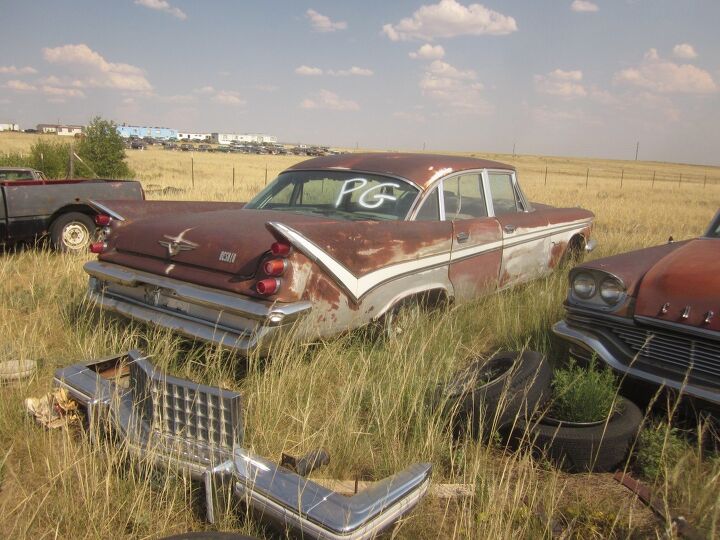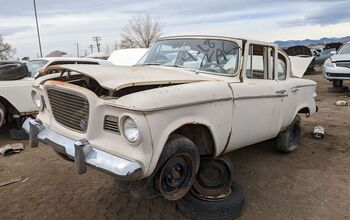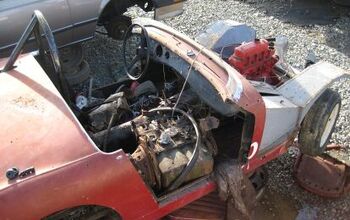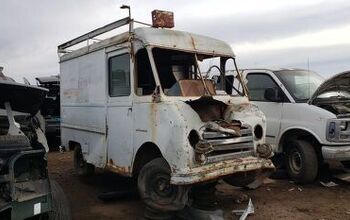Junkyard Find: 1959 DeSoto

I haven’t been to the Brain-Melting Colorado Junkyard (where I bought my 1941 Plymouth sedan) for a while, but I’ve still got quite a few photographs of the thousands of old American cars that live there. We’ve seen this ’62 Cadillac, this ’52 Kaiser, this ’49 Kaiser, this ’51 Nash, this ’51 Frazer, this mystery custom, this ’48 Pontiac hearse, and a few more, and today we’ll admire an example of DeSoto‘s final years.
The Swedes who come to the Brain-Melting Junkyard every year and fill shipping containers with old American cars and parts may have grabbed this car by now, since they love big finned American sedans in Scandinavia.
It’s pretty rusty, but most of the trim and glass look good.
Most of the cars were saved from The Crusher by the yard’s owner, who spent decades hanging around the gates of Denver’s scrappers, offering a few bucks more than the going rate for anything interesting. Better that this one get shipped to Europe than head back to the steel jaws.

Murilee Martin is the pen name of Phil Greden, a writer who has lived in Minnesota, California, Georgia and (now) Colorado. He has toiled at copywriting, technical writing, junkmail writing, fiction writing and now automotive writing. He has owned many terrible vehicles and some good ones. He spends a great deal of time in self-service junkyards. These days, he writes for publications including Autoweek, Autoblog, Hagerty, The Truth About Cars and Capital One.
More by Murilee Martin
Latest Car Reviews
Read moreLatest Product Reviews
Read moreRecent Comments
- Jalop1991 In a manner similar to PHEV being the correct answer, I declare RPVs to be the correct answer here.We're doing it with certain aircraft; why not with cars on the ground, using hardware and tools like Telsa's "FSD" or GM's "SuperCruise" as the base?Take the local Uber driver out of the car, and put him in a professional centralized environment from where he drives me around. The system and the individual car can have awareness as well as gates, but he's responsible for the driving.Put the tech into my car, and let me buy it as needed. I need someone else to drive me home; hit the button and voila, I've hired a driver for the moment. I don't want to drive 11 hours to my vacation spot; hire the remote pilot for that. When I get there, I have my car and he's still at his normal location, piloting cars for other people.The system would allow for driver rest period, like what's required for truckers, so I might end up with multiple people driving me to the coast. I don't care. And they don't have to be physically with me, therefore they can be way cheaper.Charge taxi-type per-mile rates. For long drives, offer per-trip rates. Offer subscriptions, including miles/hours. Whatever.(And for grins, dress the remote pilots all as Johnnie.)Start this out with big rigs. Take the trucker away from the long haul driving, and let him be there for emergencies and the short haul parts of the trip.And in a manner similar to PHEVs being discredited, I fully expect to be razzed for this brilliant idea (not unlike how Alan Kay wasn't recognized until many many years later for his Dynabook vision).
- B-BodyBuick84 Not afraid of AV's as I highly doubt they will ever be %100 viable for our roads. Stop-and-go downtown city or rush hour highway traffic? I can see that, but otherwise there's simply too many variables. Bad weather conditions, faded road lines or markings, reflective surfaces with glare, etc. There's also the issue of cultural norms. About a decade ago there was actually an online test called 'The Morality Machine' one could do online where you were in control of an AV and choose what action to take when a crash was inevitable. I think something like 2.5 million people across the world participated? For example, do you hit and most likely kill the elderly couple strolling across the crosswalk or crash the vehicle into a cement barrier and almost certainly cause the death of the vehicle occupants? What if it's a parent and child? In N. America 98% of people choose to hit the elderly couple and save themselves while in Asia, the exact opposite happened where 98% choose to hit the parent and child. Why? Cultural differences. Asia puts a lot of emphasis on respecting their elderly while N. America has a culture of 'save/ protect the children'. Are these AV's going to respect that culture? Is a VW Jetta or Buick Envision AV going to have different programming depending on whether it's sold in Canada or Taiwan? how's that going to effect legislation and legal battles when a crash inevitibly does happen? These are the true barriers to mass AV adoption, and in the 10 years since that test came out, there has been zero answers or progress on this matter. So no, I'm not afraid of AV's simply because with the exception of a few specific situations, most avenues are going to prove to be a dead-end for automakers.
- Mike Bradley Autonomous cars were developed in Silicon Valley. For new products there, the standard business plan is to put a barely-functioning product on the market right away and wait for the early-adopter customers to find the flaws. That's exactly what's happened. Detroit's plan is pretty much the opposite, but Detroit isn't developing this product. That's why dealers, for instance, haven't been trained in the cars.
- Dartman https://apnews.com/article/artificial-intelligence-fighter-jets-air-force-6a1100c96a73ca9b7f41cbd6a2753fdaAutonomous/Ai is here now. The question is implementation and acceptance.
- FreedMike If Dodge were smart - and I don't think they are - they'd spend their money refreshing and reworking the Durango (which I think is entering model year 3,221), versus going down the same "stuff 'em full of motor and give 'em cool new paint options" path. That's the approach they used with the Charger and Challenger, and both those models are dead. The Durango is still a strong product in a strong market; why not keep it fresher?








































Comments
Join the conversation
My parents had a 57 Chrysler Windsor that we drove from Dayton, OH to Houston, TX in August of 1958 when we moved to TX. We broke down some where in TX with alternator problems (yes Chrysler was one of the first to use alternators). I remember the deep blue metallic paint was fading even after less than a year. My parents traded it for a new 1959 Plymouth Sport Suburban 9 passenger wagon with air which my middle brother wrecked 3 years later. My mother love the push button drive and the big fins but these cars were crap. My father said he wished that he would have bought a 57 Chevy instead. The 57 Chevy was a sales flop in 1957 outsold by Ford but look at which car has become the classic. The 57 Chrysler was a sharp looking car with its dark blue and white two-tone color but is was a bad car. I remember seeing it later and someone had painted it all white which was a good choice since the blue paint was fading and wearing off.
It is hard to imagine the styling sensation that the 1957 Chrysler products were when they were first introduced . I recall at the time ,and I was possibly only three years old , practically drooling over the pink 1957 Plymouth that belonged to the parents of our unpleasant babysitter, Emma Jo . They lived nearby so I frequently gazed lustfully at this probably low level pink sedan . Knew nothing of the quality problems back then but I was only 3 years old . I thought that Mom's 1956 Pontiac two-door wagon looked so dated and frumpy in comparison .